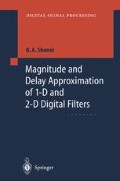Abstract
Electric wave filters, called simply as filters in this book, are circuits that are used to selectively filter out some of the frequency components of an input signal and transmit the remaining components as the output signal in such a way that the quality of information contained in the signal is improved. We consider continuous-time signals, one-dimensional (1-D) and two-dimensional (2-D) discrete-time signals as the input and output of filters and characterize them in the frequency domain by their appropriate Fourier Transform. For example, if x (t) and y(t) are the continuous-time, input and output signals of a linear, time-invariant, continuous-time filter, their Fourier Transforms X (jω) and Y(jω) are related by the equation Y(jω) = H(jω)X(jω) where H(jω) is the Fourier Transform of the unit impulse response h(t) of the continuous-time filter. The relation can also be expressed in terms of these complex valued functions as
We see that the magnitude of the output as a function of frequency is |H (jω)| times the magnitude |X (jω)| of the input signal as a function of the frequency and the phase angle of the output signal is the phase angle of the input increased by that of H(jω). Therefore by properly shaping the magnitude of H(jω) and the phase angle θ(jω) as a function of frequency, we can design the filter to transmit some frequencies and block out other frequencies as we decide.
Access this chapter
Tax calculation will be finalised at checkout
Purchases are for personal use only
Preview
Unable to display preview. Download preview PDF.
Bibliography
M. Abramowitz and I.A. Stegun, Handbook of Mathematical Functions, Dover, NY, 1965.
A. Antoniou, Digital Filters: Analysis, Design and Applications, McGraw-Hill, NY, 1993.
J.W. Sandler and B.L. Bardakjian, “LeastP th optimization of recursive digital filters,” IEEE Trans. on Audio and Electroacoustics, vol. 21, pp. 460–470, October 1973.
J.W. Sandler and R.E. Seviora, “Current trends in network optimization,” IEEE Trans. on Microwave Theory and Techniques,MTT-18, pp. 1159–1170, December 1970.
C.S. Burrus and T.W. Parks, “Time domain design of recursive digital filters,” IEEE Trans. on Audio and Electroacoustics, AU-18, pp. 137–141, 1970.
C. Charalambous, “Acceleration of least p thalgorithm for minimax optimization with engineering applications,” Mathematical Programming, vol. 17, pp. 270–297, 1979.
Erich Christian and Egon Eisenmann, Design Tables and Graphs, John Wiley, NY, 1966.
A.G. Constantinides, “Spectral transformations for digital filters,” Proc. IEE, vol. 117 No. 8, pp. 1585–1590, August 1970.
S. Darlington, “A history of network synthesis and filter theory for circuits composed of resistors, inductors and capacitors,” IEEE Trans. on Circuits and Systems, CAS-31, pp. 3–12, January 1984.
R.W. Daniels, Approximation Methods for Electronic Filter Design, McGraw-Hill, 1974.
A.G. Evans and R. Fischl, “Optimal least squares time domain synthesis of recursive digital filters,” ibid, AU-21, pp. 61–65, 1973.
FILSYN Software for Filter Analysis and Design, DGS Associates, 1353 Santa Way, Santa Clara, CA 95051.
R.A. Friedenson et al, “RC-Active filters for the D-3 Channel Bank,” B.S.T.J. vol. 54, pp. 507–529, 1975.
A.H. Gray, Jr. and J.D. Markel, “A computer program for designing digital elliptic filters,” IEEE Trans. on Acoustics, Speech and Signal Processing, ASSP-24, pp. 529–538, June 1976.
O. Heaviside, Electromagnetic Theory, 1893 (Reprinted by Dover Publications, New York, 1950).
D.S. Humpherys,The Analysis, Design and Synthesis of Electrical Filters, Prentice-Hall, 1970.
The Signal Processing Toolbox and MATLAB(R)-Software from The Mathworks Inc, Natick, MA.
S.K. Mitra and J.F. Kaiser (Eds.), Handbook for Digital Signal Processing, John Wiley&Sons, 1993.
A.V. Oppenheim and R.W. Schafer, Discrete-Time Signal Processing, Prentice-Hall, 1989.
A. Papoulis, “A new class of filters,” Proc.IRE, vol. 46, pp. 649–653, March 1958.
T.W. Parks and C.S. Burrus, Digital Filter Design,John Wiley, NY, 1987.
J.G. Proakis and D.G. Manolakis, Digital Signal Processing-Principles, Algorithms, and Applications, Prentice-Hall 1996.
M.I. Pupin, “Wave transmission over non-uniform cables and long distance air lines,” Trans. AIEE, vol. 17, pp. 445–507, 1900.
R. Schaumann, M.S. Ghausi and K.R. Laker, Design of Analog Filters(Appendix), Prentice-Hall, 1981.
A.S. Sedra and P.O. Bracket,Filter Theory and Design: Active and Passive,ISBS Inc, Forest Grove, OR, 1978.
C.E. Shannon, “Communication in the Presence of Noise,” Proc. IRE, pp. 10–12, January 1949.
A.K. Shaw, “Optimal identification of discrete-time systems from impulse response,” IEEE Trans. on Signal Processing, vol. 42, no. 1, pp. 113–120, January 1994.
A.K. Shaw, “Optimal design of digital IIR filters by model-fitting frequency response data,” IEEE Trans. on Circuits and Systems, vol. 42, pp. 702–710, November 1995.
G.C. Temes and J.W. LaPatra, Introduction to Circuit Synthesis and Design, McGraw-Hill, 1977.
G.C. Temes and D.Y.F. Zai, “Least pth approximation,” IEEE Trans. on Circuit Theory, CT-16, pp. 235–237, May 1969.
W. Thomson, “On the theory of the electric telegraph,” Phil. Mag. vol. 11, pp. 146–160, 1856.
P.P. Vaidyanathan, “Optimal design of linear phase FIR digital filters with very flat passband and equiripple stopbands,” IEEE Trans. on Circuits and Systems, vol. CAS-32, pp. 904–907, September 1985.
A.I. Zverev, Handbook of Filter Synthesis, John Wiley, NY, 1967.
Author information
Authors and Affiliations
Rights and permissions
Copyright information
© 1999 Springer-Verlag Berlin Heidelberg
About this chapter
Cite this chapter
Shenoi, B.A. (1999). Classical Methods of Magnitude Approximation. In: Magnitude and Delay Approximation of 1-D and 2-D Digital Filters. Digital Signal Processing. Springer, Berlin, Heidelberg. https://doi.org/10.1007/978-3-642-58573-9_1
Download citation
DOI: https://doi.org/10.1007/978-3-642-58573-9_1
Publisher Name: Springer, Berlin, Heidelberg
Print ISBN: 978-3-642-63652-3
Online ISBN: 978-3-642-58573-9
eBook Packages: Springer Book Archive

